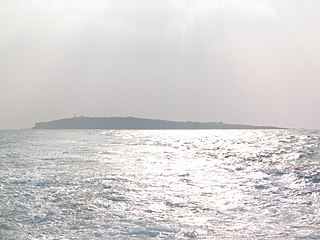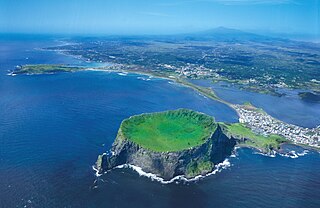
Jeju Province, officially Jeju Special Self-Governing Province, is the southernmost province of South Korea, consisting of eight inhabited and 55 uninhabited islands, including Mara Island, Udo Island, the Chuja Archipelago, and the country's largest island, Jeju Island. The province is located in the Korea Strait, with the Korean Peninsula to the northwest, Japan to the east, and China to the west. The province has two cities: the capital Jeju City, on the northern half of the island and Seogwipo, on the southern half of the island. The island is home to the shield volcano Hallasan, the highest point in South Korea. Jeju and Korean are the official languages of the province, and the vast majority of residents are bilingual.

Jeju City is the capital of the Jeju Province in South Korea and the largest city on Jeju Island. The city is served by Jeju International Airport.

Seogwipo is the second-largest city on Jeju Island, settled on a rocky volcanic coastline in the southern part of Jeju Province, South Korea. In July 2006, Seogwipo's boundaries were expanded to include the entire southern half of Jeju island. A UNESCO World Heritage Site and 2002 FIFA World Cup host, it had a population of 192,566 as of the end of February, 2024.

Marado (Korean: 마라도) or Mara Island is an island in Jeju Province, South Korea. It is South Korea's southernmost island, and is 8 km (5.0 mi) off the south coast of Jeju Island.

Gotjawal (Korean: 곶자왈) is a Jeju-language term for a dense and wild forest. The term is now used to describe the forest biome of Jeju Island, in Jeju Province, South Korea.

Jeju Olle Trail (Korean: 제주올레길) is a long-distance footpath on Jeju Island, in Jeju Province, South Korea. The trail consists of 21 connected numbered main routes, 6 sub-routes, and a short spur that connects to Jeju International Airport. On average, the routes are 16 km in length and total 437 km. They mainly follow Jeju's coastline and around its outlying islands, passing beaches, fishing villages, indigenous forest, tourist destinations, and urban centers. The exact length and locations change over time as trails are modified or re-routed. Jeju Olle Trail was envisioned and developed by former journalist Suh Myung-sook.

Udo, also known as U Island and sometimes Soseom (소섬), is an island in Jeju Province, South Korea. It is 2.8 km (1.7 mi) off the coast of Jeju Island, and is the second-largest island in the province.

Seongsan Ilchulbong (Korean: 성산일출봉), also called Sunrise Peak, is a volcano on eastern Jeju Island, in Seongsan-ri, Seogwipo, Jeju Province, South Korea. It is 182 meters high and has a volcanic crater at the top.

Oreum refers to the around 360 small rising extinct volcanoes on Jeju Island, in Jeju Province, South Korea. They are commonly described as cinder cones or parasitic cones, and are often inside larger volcanic craters.

Soesokkak, alternatively Soesokkak Estuary or Soesokkak River Pool, is a landform on Jeju Island in Seogwipo, Jeju Province, South Korea.

Jungmun Saekdal Beach (Korean: 중문색달해수욕장) is a beach in Saekdal-dong, Seogwipo, Jeju Province, South Korea. The beach is 560 meters long and 50 meters wide, and the sand features a variety of colors, including black, white, red, and gray.

Sanbangsan is a volcano located on the southwest coast of Jeju Island, in Andeok-myeon, Seogwipo, Jeju Province, South Korea. It is a trachytic lava dome that is 395 m (1,296 ft) tall.

Jeongnang is a term for traditional gates to private homes of Jeju Island, Korea. The gates are typically composed of three parallel wooden poles placed in holes in wood or stone pillars. They have a number of purposes, one of which is to quickly communicate to neighbors if the owner of the house is at home.
Olle refers to traditional walled alleyways that connect houses to main paths in Jeju Province, South Korea. They are considered to be part of Jeju's tradition of piled stone structures, called doldam. They are now considered less common, although they are seen as symbols of Jeju.

Doldam refers to traditional cultural practices surrounding the use of piled volcanic stones on Jeju Island, Korea. Doldam structures have been present on Jeju Island for many centuries and are considered quintessential symbols of Jeju's culture and aesthetic.

Seogwipo Rural Five-Day Market is a traditional market that operates once every five days, located in Donghong-dong, Seogwipo, South Korea.

Seongeup Folk Village (Korean: 성읍민속마을) is a traditional Korean folk village in Pyoseon-myeon, Seogwipo, Jeju Province, South Korea. It has been continually inhabited for around 600 years, since the 15th century, and is maintained to resemble its traditional pre-modern form.
Gama Oreum is an oreum in Cheongsu-ri, Hangyeong-myeon, Jeju City, Jeju Province, South Korea.

Saeseom (Korean: 새섬) is an island in Seogwipo Port in Seogwipo-dong, Seogwipo, Jeju Province, South Korea. It has an area of 104,137 m2 (1,120,920 sq ft) and is relatively short, with its highest point at 19 m (62 ft) above sea level. It is connected to the mainland via Saeyeon Bridge. Much of the island is a park called Saeseom Park (새섬공원).





















